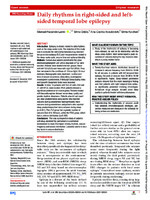JavaScript is disabled for your browser. Some features of this site may not work without it.
Mostrar el registro sencillo del ítem
| dc.contributor.author | Latini, Manuel Facundo | |
| dc.contributor.author | Oddo, Silvia | |
| dc.contributor.author | Anzulovich, Ana Cecilia | |
| dc.contributor.author | Kochen, Silvia | |
| dc.date.accessioned | 2023-08-16T14:23:01Z | |
| dc.date.available | 2023-08-16T14:23:01Z | |
| dc.date.issued | 2022-04-10 | |
| dc.identifier.citation | Latini MF, Oddo S, Anzulovich AC, et alDaily rhythms in right-sided and left-sided temporal lobe epilepsyBMJ Neurology Open 2022;4:e000264. doi: 10.1136/bmjno-2021-000264 | es_AR |
| dc.identifier.other | doi: 10.1136 | |
| dc.identifier.uri | http://repositorio.hospitalelcruce.org/xmlui/handle/123456789/1398 | |
| dc.description | Fil: Latini, Manuel Facundo Epilepsy, Hospital El Cruce ,Buenos Aires. Buenos Aires; Argentina | es |
| dc.description | Fil: Oddo, Silvia Epilepsy Center, José María Ramos Mejía General Hospital, Buenos Aires. CABA; Argentina | es |
| dc.description | Fil: Anzulovich, Ana Cecilia Chronobiology, UNSL, San Luis. San Luis; Argentina | es |
| dc.description | Fil: Kochen, Silvia Epilepsy, Hospital El Cruce, Buenos Aires. Buenos Aires; Argentina | es |
| dc.description.abstract | Introduction Epilepsy is closely related to daily rhythms, such as the sleep–wake cycle. The objective of this study was to evaluate the relationship between drug-resistant temporal lobe epilepsy (TLE) and the parameters related to the sleep–wake cycle, seizure time and epilepsy laterality. Methods Consecutive patients admitted to the video electroencephalogram unit with a diagnosis of TLE were enrolled. Patients were divided into two groups: those with left TLE (LTLE) and those with right TLE (RTLE). They then remained in the conditions of 12-hour light, 12-hour darkness. Demographic data, treatment, number and time of seizure occurrence, sleep diary, morningness–eveningness questionnaire, Pittsburgh Sleep Quality Index and Epworth Sleepiness Scale were recorded. Results In total, 74 patients with TLE, 43 with LTLE and 31 with RTLE, were studied. RTLE patients showed a significant preference for morningness. Patients treated with benzodiazepines showed worse sleep quality and greater daytime sleepiness. Patients who did not report any clear predominance and patients who reported seizures during wakefulness had significantly more seizures during wakefulness and patients who reported sleep predominance had more seizures during sleep (p>0.001). The LTLE group had a greater number of seizures from 8 to 16 hours, unlike the RTLE group, which had a uniform distribution (p=0.008). Conclusions This was a prospective study of patients with drug-resistant TLE performed in a controlled environment to study the impact of daily rhythms, seizure frequency and seizure distribution. Laterality seems to be a key factor in seizure distribution. | es_AR |
| dc.language.iso | es | es_AR |
| dc.relation.ispartofseries | BMJ Neurology Open 2022;4:e000264. doi: 10.1136/bmjno-2021-000264; | |
| dc.subject | temporal lobe epilepsy | es_AR |
| dc.subject | Epilepsy | es_AR |
| dc.subject | rhythmicity of epilepsy | es_AR |
| dc.title | Daily rhythms in right-sided and left-sided temporal lobe epilepsy | es_AR |
| dc.type | Article | es_AR |
Ficheros en el ítem
Este ítem aparece en la(s) siguiente(s) colección(ones)
-
15º Jornadas Científicas y de Gestión 2022
15º Jornadas Científicas y de Gestión 2022

